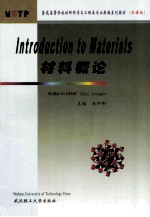图书介绍
普通高等学校材料科学与工程类专业新编系列教材 材料概论 双语版PDF|Epub|txt|kindle电子书版本网盘下载

- 水中和主编 著
- 出版社: 武汉:武汉理工大学出版社
- ISBN:7562923353
- 出版时间:2005
- 标注页数:283页
- 文件大小:54MB
- 文件页数:294页
- 主题词:
PDF下载
下载说明
普通高等学校材料科学与工程类专业新编系列教材 材料概论 双语版PDF格式电子书版下载
下载的文件为RAR压缩包。需要使用解压软件进行解压得到PDF格式图书。建议使用BT下载工具Free Download Manager进行下载,简称FDM(免费,没有广告,支持多平台)。本站资源全部打包为BT种子。所以需要使用专业的BT下载软件进行下载。如BitComet qBittorrent uTorrent等BT下载工具。迅雷目前由于本站不是热门资源。不推荐使用!后期资源热门了。安装了迅雷也可以迅雷进行下载!
(文件页数 要大于 标注页数,上中下等多册电子书除外)
注意:本站所有压缩包均有解压码: 点击下载压缩包解压工具
图书目录
1 Introduction to Materials1
1.1 Materials and Material Science1
1.1.1 How Is a Material Defined?1
1.1.2 The Three Classes of Materials1
1.1.3 Materials Properties3
1.1.4 Use of Materials4
1.1.5 Materials Science4
1.2 Types of Materials10
1.2.1 Metal10
1.2.2 Ceramics and Glasses10
1.2.3 Polymers11
1.2.4 Composites12
1.3 Structural Characteristic of Materials16
1.3.1 Crystal Lattice17
1.3.2 Crystallographic Indices19
1.3.3 Anisotropy20
1.4 Structure-property-processing Relationship26
1.4.1 Properties26
1.4.2 Structure28
1.4.3 Processing29
1.4.4 Structure-property-processing Interaction29
Questions and Problems33
References34
2 Metallic Materials35
2.1 Metals35
2.2 Ferrous Metals35
2.2.1 Ferrous Metals Group35
2.2.2 Production ofIron36
2.2.3 Production of Steel37
2.2.4 Cast Iron Alloys38
2.2.5 Steels40
2.3 Nonferrous Metals51
2.3.1 Introduction51
2.3.2 Nonferrous Metals in Common Use51
2.3.3 Titanium,Nickel,and Cobalt57
2.3.4 Other Nonferrous Metals59
2.4 The Physical and Mechanical Properties of Metals64
2.4.1 Mechanical Properties64
2.4.2 Metals at Low Temperatures66
2.4.3 Physical Properties66
2.5 The Crystal Structure of Metals68
2.5.1 Bonding of Metals68
2.5.2 Metals and Nonmetals68
2.5.3 Crystalline Unit Structures68
2.6 Corrosion71
Questions and Problems73
References74
3 Ceramic Materials75
3.1 Introduction75
3.2 Nature of Ceramics82
3.2.1 Porosity and Density83
3.2.2 Structure of Ceramics85
3.2.3 Ceramic Phase Diagrams86
3.3 Ceramic Processing90
3.3.1 Traditional Processing90
3.3.2 Advanced Ceramic Processing95
3.4 Properties of Ceramics106
3.4.1 Mechanical Properties107
3.4.2 Physical Properties109
3.4.3 Chemical Properties109
3.4.4 Fabricability110
3.4.5 Other Properties111
3.4.6 Designing Ceramics114
3.5 Applications of Ceramics121
Questions and Problems127
References128
4 The Glass Sciences129
4.1 The World of Glasses129
4.1.1 Natural Glasses129
4.1.2 Glass in Modem Times129
4.1.3 Different Types of Glasses131
4.2 Preparation Technologies of Glasses136
4.2.1 Preparation of Glasses136
4.2.2 Microwave Heating in Glass Preparation137
4.2.3 Sol-gel Process138
4.2.4 Chemical Nature of Glass Forming Materials138
4.2.5 Structural Approach to Glass Formation139
4.3 Structures and Properties of Glasses141
4.3.1 Continuous Random Network Model142
4.3.2 Random Close Packing Model143
4.3.3 Bonding Theories143
4.3.4 Kinetic Criteria for Glass Formation144
4.3.5 Thermal Behaviour of Glasses144
4.3.6 Physical Properties146
4.3.7 Optical Properties147
4.3.8 Chemical Stability147
4.3.9 Electrical Nature of Glass149
4.4 Applications of Glasses155
4.4.1 Glass Products156
4.4.2 Architectural Glass156
4.4.3 Anti-solar Glass157
4.4.4 Zero-expansion Transparent Glass Ceramics157
4.4.5 Glass for Active-matrix Liquid-crystal Display Panels157
4.4.6 Fibre Optics158
4.4.7 Fine Particulates and Nano-glasses159
4.5 Recent Topics of Optoelectronics Materials162
4.5.1 Blue and Green Light Sources163
4.5.2 Optical Switches164
4.5.3 Optical Fibers164
Questions and Problems168
5 Cement and Concrete Materials169
5.1 Portland Cement and Its Major Constituent Phases169
5.1.1 Portland Cement General169
5.1.2 Types ofPortland Cement170
5.1.3 Cement Chemical Nomenclature and Other Abbreviations171
5.2 Getting Acquainted with Concrete176
5.2.1 Properties Desired in Fresh or Plastic Concrete177
5.2.2 Properties Desired in Hardened Concrete177
5.2.3 Properties ofConcrete178
5.2.4 Variables That Influence Concrete Quality178
5.2.5 Consumer Product Safety179
5.3 Concrete:Strength and Behavior183
5.3.1 Introduction183
5.3.2 Uniaxial Behavior183
5.3.3 Tension Strength185
5.4 Uses of Concrete190
5.4.1 Reinforced Concrete190
5.4.2 Prestressed Concrete191
5.4.3 Precast Concrete191
5.4.4 Lightweight Concrete192
5.4.5 Thin Shell192
5.4.6 Shotclete193
5.4.7 Construction with Prefabricated Concrete Units194
5.5 New Type of Cement-based Materials199
5.5.1 General199
5.5.2 DSP Concretes200
5.5.3 MDF Cements200
Questions and Problems202
References202
6 Polymer Materials203
6.1 Polymer and Nomenclature203
6.1.1 Nomenclature Based on Source203
6.1.2 Nomenclature Based on Structure(Non-IUPAC)204
6.1.3 IUPAC Structure-based Nomenclature System204
6.1.4 Trade Names and Nonnames205
6.2 Polymer Synthesis211
6.3 Structure-property Relations219
6.3.1 General consideration219
6.3.2 Control of Tm and Tg220
6.3.3 Relation between Tm and Tg223
6.4 Mechanical Properties of Elastomers,Fibers,and Plastics227
6.4.1 Mechanical Proporties227
6.4.2 Elastomers,Fibers,and Plastics229
6.5 Polymeric Biomaterials for Tissue and Organ Regeneration234
Questions and Problems239
References239
7 Composite Materials241
7.1 An Overview of Composites241
7.1.1 Introduction241
7.1.2 Definition ofComposites242
7.1.3 Materials ofConstruction243
7.2 Surface Treatment of Reinforcing Materials249
7.2.1 Cost Factor249
7.2.2 Chemistry ofSurface Treatment and Interfacial Structure249
7.3 Mechanical Property of Polymeric Composite258
7.3.1 Introduction258
7.3.2 Polymer Marx Composites258
7.4 Smart Structural Composites264
7.4.1 Cement-matrix Composites265
7.4.2 Polymer-marx Composites268
7.5 Framework for Nanocomposites275
Questions and Problems282
References283